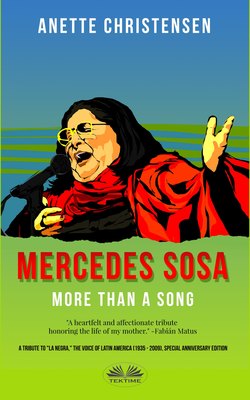Читать книгу Mercedes Sosa - More Than A Song - Anette Christensen - Страница 8
Buenos Aires, October 4, 2009
ОглавлениеFOLLOWING THE President’s official announcement marking the start of three national days of mourning, the flags are flown at half-mast all over Argentina. Across the country concerts and shows scheduled during this period are cancelled, and condolences from heads of state—in Latin America and the rest of the world—pour in.
“La Negra” (The Black One), as she was fondly called owing to her jet black hair and her Northern Argentine, Andean ancestry, lies peacefully in her casket in the most formal room of the Congress, the “Salón de los Pasos Perdidos,” an honor reserved for only the most prominent of national icons. On Avenida Callao, the street leading to the Congress, admirers line up to pay their respects.1
In the Pasos Perdidos, lavish wreaths adorn the impressive marble hall. Gigantic chandeliers and massive candles light up the dimness of the high-ceilinged room with the uncovered casket positioned right in the center. Argentina’s president, Cristina Fernández de Kirchner, accompanies Sosa’s family as they pay homage to the singer. The family, including Mercedes’ son, Fabián Matus, and her two grandchildren, Agustín and Araceli, stand closely with their arms around each other as though in a half-embrace while Cristina caresses Mercedes Sosa’s lifeless hand. Christina’s husband, the former President Néstor Kirchner, stands rather guardedly by her side with a cautious look.
Ordinary people are there too. Respectfully, a growing flock of mourners pass by the open casket where she is seen resting in her embroidered blue dress. Her long, black hair, which at the age of seventy-four, doesn’t have a single strand of gray in it, frames her calm, high-cheekbone face. Her hands are carefully folded on her stomach around a bouquet of white roses. Singer Argentino Luna plays her songs as weeping fans sing along and take turns to leave flowers by her coffin.
October 5, 2009
FABIÁN AND Mercedes’ closest relatives follow the brown wooden casket as it is carried out to the hearse parked outside the Congress. All along Avenida Rivadavia, crowds of mourners, of all ages, gather to watch the hearse take her on her last journey, from the Congress to the crematorium. They stand united in a moment of Argentine history that dissolves social and political boundaries.
The procession of hearses drives past slowly and a number of mourners carry banners that say adorable things about her. An old revolutionary in his sixties is holding up a banner that reads, “Thank you for your life and your struggle.” A number of people can be seen clapping and waving the Argentine flag with graceful enthusiasm. The young make happy noises, chanting, “Olé Olé Olé Olé, Negra Negra,” in repeated fashion as though it were the national soccer team returning after winning a championship. At virtually every corner, groups of people bearing different instruments start to sing. Beautiful music echoes through the streets of Buenos Aires—music that has provided hope and comfort for decades, challenging tyranny and fostering democracy.
It is a day of sorrow that reaches deep into the Argentine soul. The national folk heroine, the mother of the nation, is dead. But what she gave through her life and her songs will never die. They live on.
The procession slowly leaves the Congress. The first hearses carry all the flower decorations. The last carries the casket.
